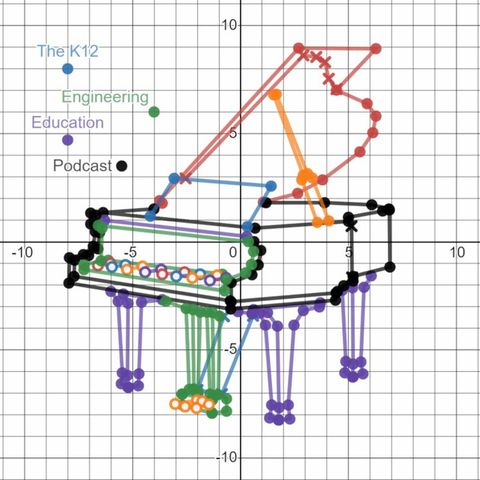What Do Equations Sound Like on the Piano?

Download and listen anywhere
Download your favorite episodes and enjoy them, wherever you are! Sign up or log in now to access offline listening.
Description
Let’s make equations musical. Instead of visualizing equations on a graph, let’s listen to them on the piano, merging all our math and music knowledge. You can make two-dimensional x-y...
show moreRelated to this episode:
• Chordinates! beta, a free web by Pios Labs: https://www.pioslabs.com/chordinates/
• Coordinate plane, from Desmos.com: https://www.desmos.com/calculator/q8mwzeylbk
• HCI Beyond the GUI, book by Philip Kortum: https://www.amazon.com/HCI-Beyond-GUI-Nontraditional-Technologies/dp/0123740177/ref=sr_1_1?ie=UTF8&s=books&qid=1241987101&sr=8-1
• Google nGram viewer, for analyzing the prevalence of the words “sonify” and “sonification”: https://books.google.com/ngrams/graph?content=sonify%2Csonification&year_start=1800&year_end=2019&corpus=26&smoothing=3&direct_url=t1%3B%2Csonify%3B%2Cc0%3B.t1%3B%2Csonification%3B%2Cc0
Music credits:
All clips used are under Creative Commons 0 Licenses, including from the following artists.
• Tyler Schanck, The Wandermiles: www.thewandermiles.com
• Doctor Dreamchip: https://www.youtube.com/channel/UCbhlcItuC6pmhhemUjhPt1w
• Moz5a: www.mankus.co.uk
• Sondre Drakensson: https://soundcloud.com/drakensson93
• Eathan Markson: https://soundcloud.com/eathan-markson
• Don Veca: https://soundcloud.com/dveca/sets/generative-jazz
• Komit: https://freesound.org/people/Komit./
• Epon Audio: https://www.patreon.com/EponAudio?fan_landing=true
• Nate Ziller: http://www.nateziller.com/
• Julian Evans: http://www.julianevans.info/
Equations referenced:
• y = x, https://www.pioslabs.com/chordinates/index.html?&x=x-scale-custom&xmin=0&xmax=51
• y = -2x, https://www.pioslabs.com/chordinates/index.html?&x=x-scale-custom¶ms=-2,0&xmin=0&xmax=51
• Linear equation, minor scale: https://www.pioslabs.com/chordinates/index.html?&m=diatonic-cminor&x=x-scale-custom¶ms=1,-1&xmin=0&xmax=51
• Linear equation, chromatic scale: https://www.pioslabs.com/chordinates/index.html?&m=chromatic&x=x-scale-chromatic-origin&y=y-scale-chromatic-origin
• y = x^2, https://www.pioslabs.com/chordinates/index.html?f=quadratic-standard&x=x-scale-custom¶ms=1,0,0&xmin=0&xmax=51
• y = 16sin(x), free rhythm, https://www.pioslabs.com/chordinates/index.html?f=trigonometric-sin&r=rhythm-even-y¶ms=16,1,0,0
• y = 5vtan((1/2)x), free rhythm, https://www.pioslabs.com/chordinates/index.html?f=trigonometric-tan&r=rhythm-even-y¶ms=5,0.5,0,0
• Square wave, amplitude = 2, offset = 2, major 3rd harmony, https://www.pioslabs.com/chordinates/index.html?f=sgn-cos&h=harmony-majorthird¶ms=2,1,2
• y = uniform random distribution, from -23 to 28, https://www.pioslabs.com/chordinates/index.html?f=statistical-rand-uniform¶ms=28,-23
Subscribe and find more podcast information at: http://www.k12engineering.net. Support Pios Labs with regular donations on Patreon: https://www.patreon.com/pioslabs. You’ll also be supporting projects like the Engineer’s Guide to Improv and Art Games, The Calculator Gator, or Chordinates! Thanks to our donors and listeners for making the show possible. The K12 Engineering Education Podcast is a production of Pios Labs: http://www.pioslabs.com.
Information
| Author | Pius Wong |
| Organization | Pius Wong |
| Website | - |
| Tags |
-
|
Copyright 2024 - Spreaker Inc. an iHeartMedia Company

Comments